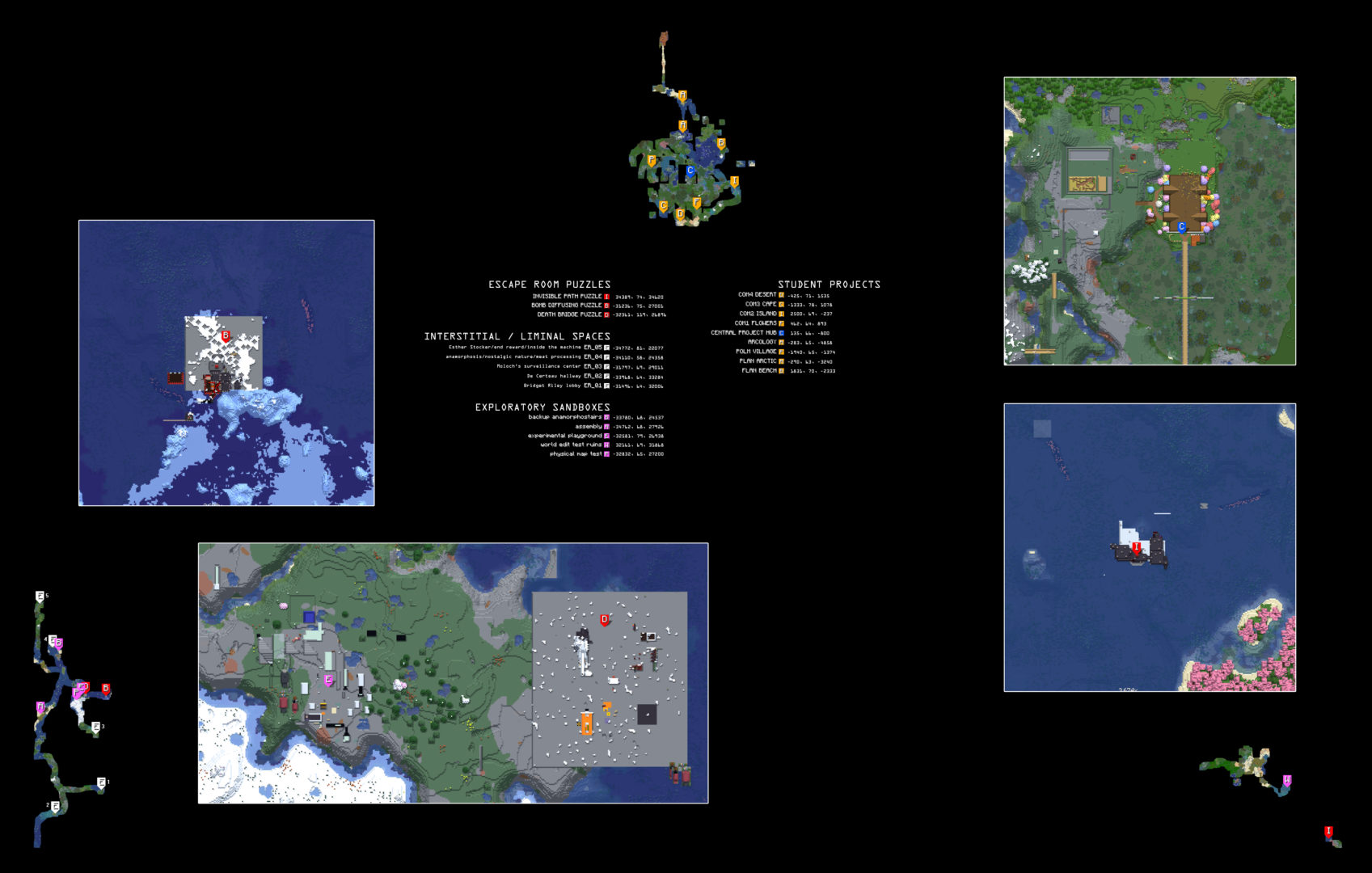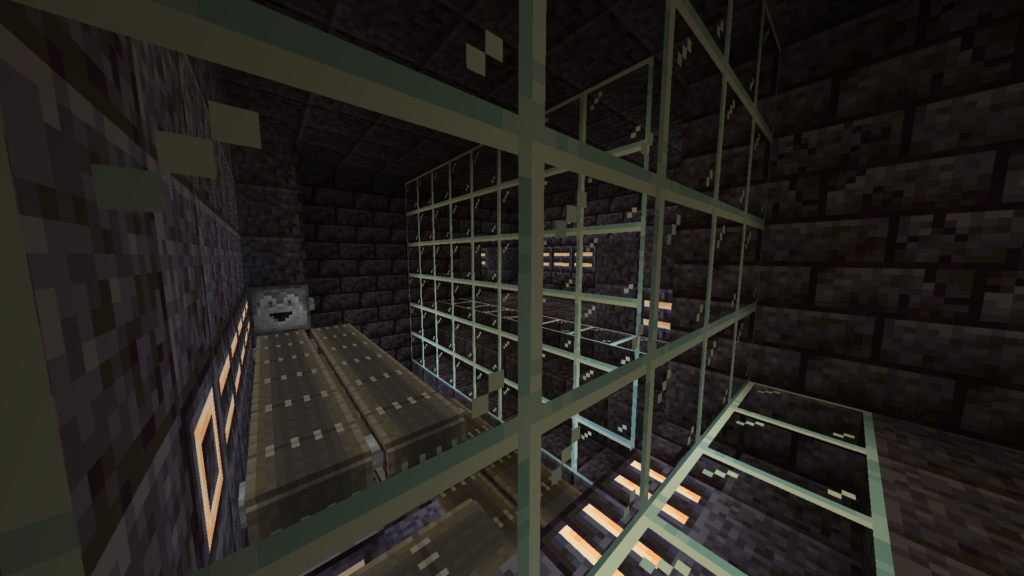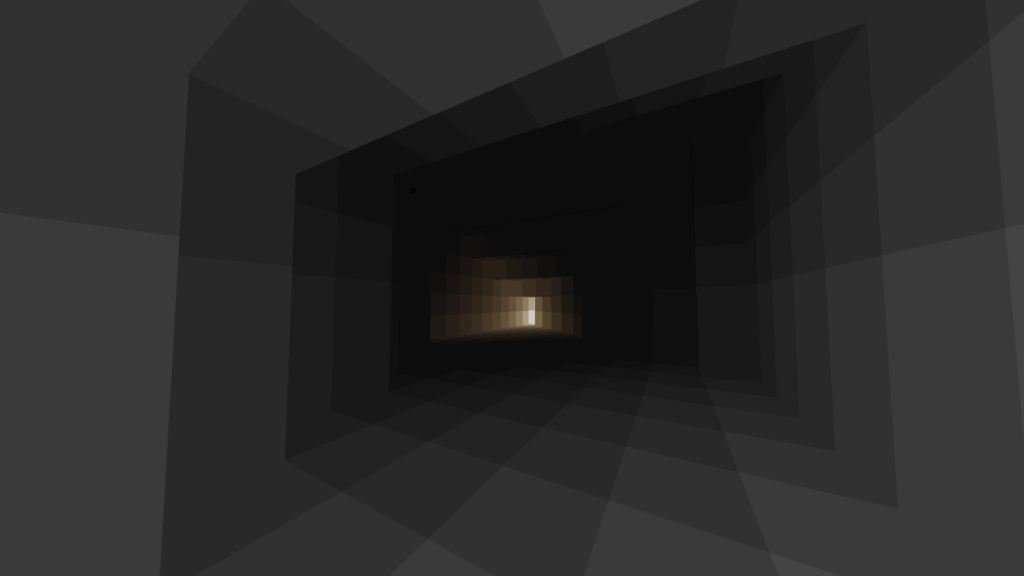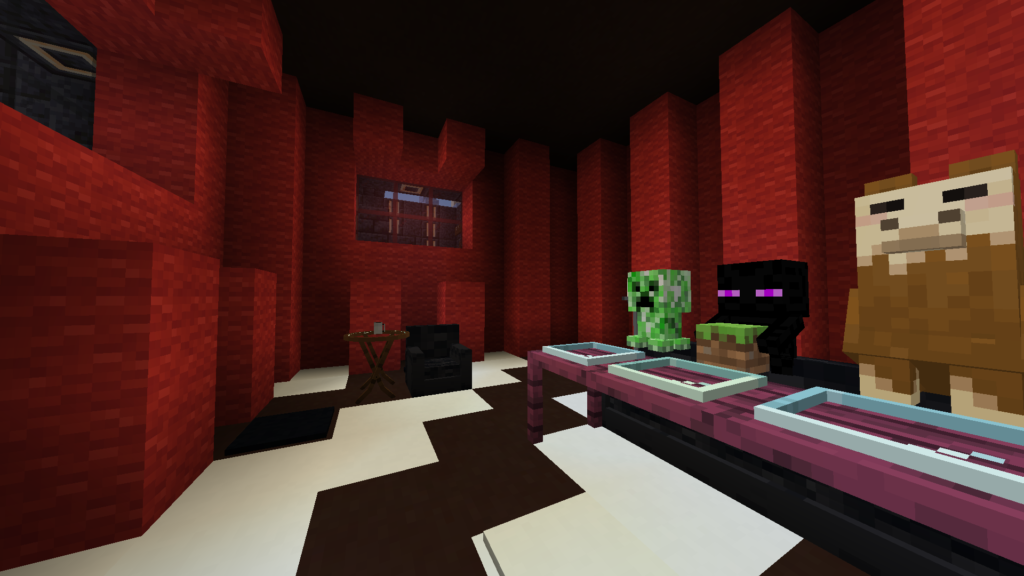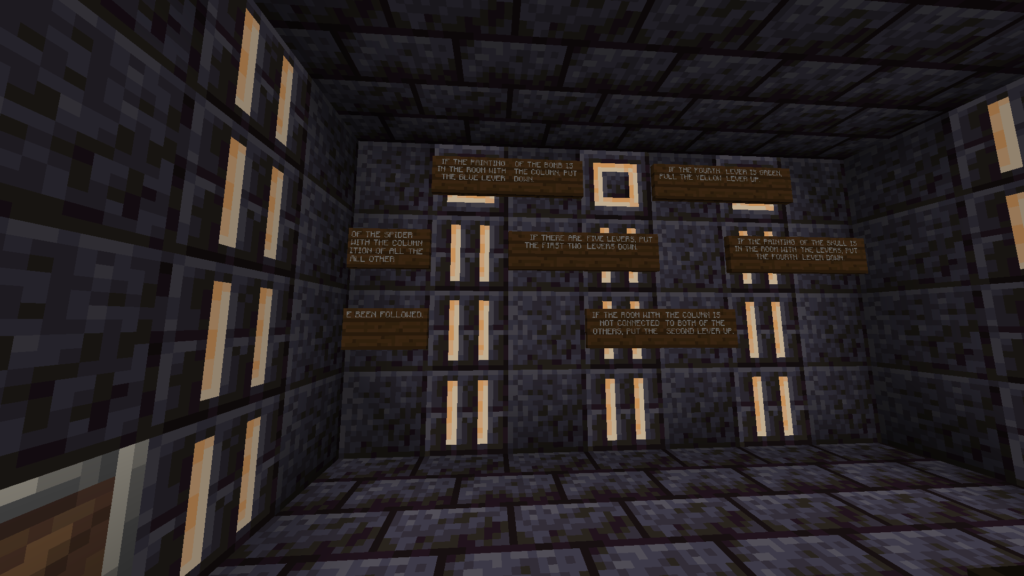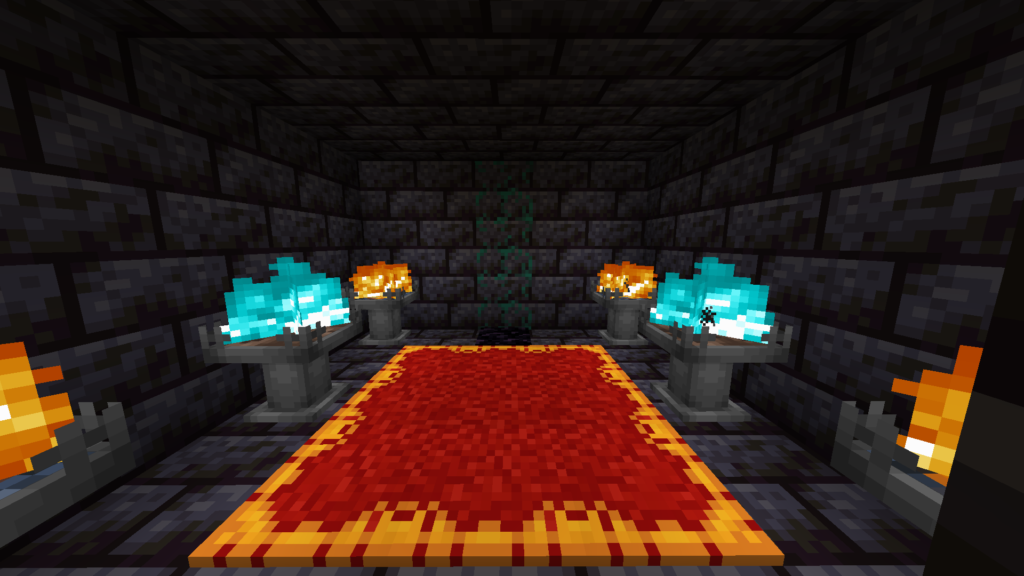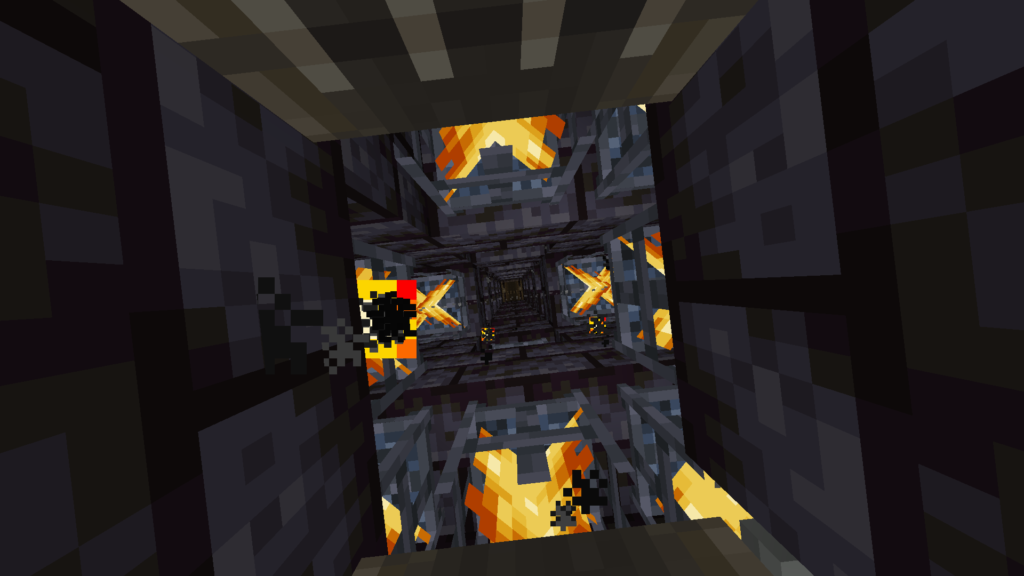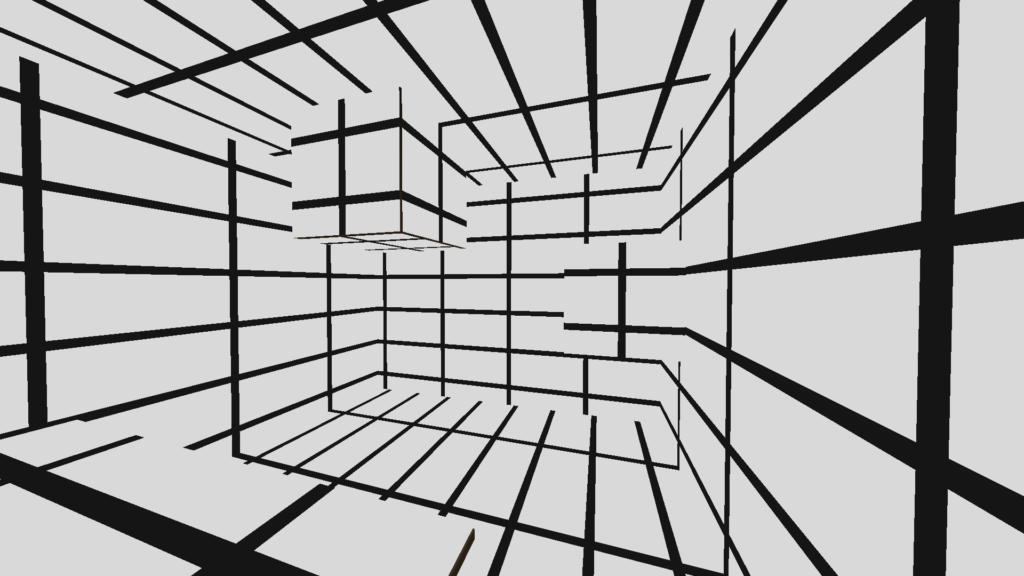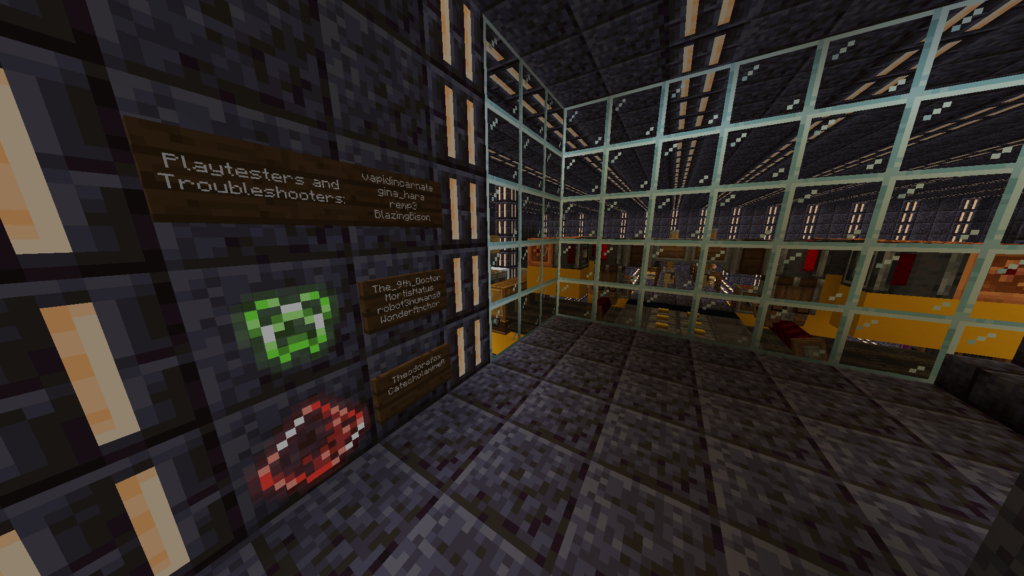Moloch’s Gauntlet: Escape to Modernity is a three-player cooperative escape room experience built for Minecraft Java Edition. What follows is a description of the project, its goals, and the aesthetic, academic and technical considerations that went into its design.
If you would like to play this experience without having any part of it spoiled, we recommend you stop reading now and instead download and install the necessary components (modpack and world file) to play it yourself. You will need Minecraft Java Edition, a multiplayer server installation, and two additional players to do so.
For specific inquiries, please reach out at minecraftstudentcabal@gmail.com
This project was created within the context of the second iteration of the course Videogames And/As Theory: Minecraft and Modernity Edition at Concordia University under the supervision of Dr. Darren Wershler, and his research partner Dr. Bart Simon.
The contributors to this project are Angelica Calcagnile, Theodore Fox, Nat Torre and Andrew Rochon. We were all students in the first iteration of the course, and were assembled into a group (the “Student Cabal”) with the aim of offering insight into any differences between how we experienced our version of the course, and how we perceived the student experience of the second version.
This project arose from the challenge of creating more opportunities for cooperation and collaboration between students.
The map above documents the various installations built on the world map, including those created by course participants as their student projects, and the various sandboxes and testing areas that we created in the elaboration of this project.
Some of the visual ideas inherent to the escape room’s aesthetic design are a continuation of some ideas Angelica negotiated as a student in the original Minecraft & Modernity class. Her final paper for the class was about kitsch, a concept Minecraft embodies thoroughly and with abandon. Through Sam Binkley in Kitsch As A Repetitive System, Angelica explored the concept that kitsch developed as a form of aesthetic resistance to modernity; as the deep changes brought about by modernity disembedded people from the existences they thought to be immutable, kitsch aesthetics offered them renewed ontological security, to borrow from Anthony Giddens. Minecraft too offers ontological security in an otherwise foreign, blocky world by being deeply representational. This literality contributes to its widespread appeal, but begs to be undermined, if not broken outright. Could the “Minecraftyness” of the game could be dismantled with limited intervention?
The first puzzle of the escape room divides the players into uneven groups: one player would need to traverse a pressure-plate filled floor carefully while the other two players navigate a labyrinth which reveals the corresponding correct path in the checkerboard room. The key is communication, because if there is a slip-up and the wrong pressure plate is stepped on then the player will be teleported to the beginning and be forced to watch a precious item slowly fall into lava via conveyor belts. This works well as the first puzzle since it introduces the communication aspect that carries through the rest of the game, but allows two players to have the chance to instruct one player. Giving the task of instruction reading to two players acts as a failsafe incase one of them is more shy or less likely to step up right away; they can support and build confidence off one another.
The three puzzles that are integrated in the final version of the escape room went through several rounds of ideation, prototyping and playtesting; you know, typical game development stuff. We started from 12 or so puzzle ideas and whittled these down to a list that fit our objectives better. Also, it is also probably worth noting that we were re-evaluating our objectives for the escape room even as we were working on the puzzles and interstitial room experiments. Therefore, a lot of the puzzle ideas we came up with, especially early on, were incompatible with our final vision. For instance, at an earlier date, we were envisioning the escape room as an experience that the whole class would partake in at the same time during class hours, hence the unused lever puzzle idea. This was a puzzle in which, on the surface, each team in the class would have to flip levers into a specific configuration using only their own set of clues, but really each team would have to realize that their clues only contained information relevant to the other teams’ puzzles, meaning they would have to communicate with all of the other teams throughout the process in order to solve their own puzzle.
Earlier iterations of the escape room made going to the next puzzle as easy as stepping through a door which would teleport you. However, in playtesting we found the group would get easily separated when one or more players would run through ahead of others and trigger later events. We can’t fault the players for doing this though, when you are presented with a puzzle the natural instinct is to explore all the different tools available in your environment. Also, sometimes the boundaries would be unclear. To solve this problem, small sections where all three players would have to step on pressure plates to move on. Players wouldn’t have to be introduced to this concept because it was already used throughout in order to separate players to run distinct commands on them.
This room was initially constructed by Theodore, and renders Minecraft’s interpretation of light physics explicit. We did a lot of experimentation with this room, attempting to see if we could color the light that spills into it before it is consumed in darkness.

Players are led through a few more light experiments on their way to the next puzzle. Where is freedom? In darkness or in light?
Moloch’s office nods to a few ideas central to modernity; surveillance, and the rise of bureaucracy. The evil of a modern demon is mundane, executed through routine tasks, not through magical power.
In our early experimentation with aesthetic concepts, we realized that if we put light sources behind high-resolution map images, we could eliminate shadows and, if using a solid colour or tone across the floors and walls, we could eliminate perspective and make spaces that looked very un-Minecraft. This became a key feature to the aesthetic-heavy interstitial rooms which are pictured in this photo set.
When Theodore was experimenting with how far he could push this lack of perspective, He created a large room which had all its surfaces backlog and covered in a fuzzy red texture. When a player stood in the middle of the room, all perspective was lost and it was difficult to even tell up from down. Unfortunately, the number of light sources a room of this size required was intense taxing on the server, and had to be copy/pasted far away from the rest of our workspace, so that it wouldn’t be actively loaded while we were working on anything else. This made clear to us that, especially for our aesthetic experiments, our maximum room size would have to be quite constrained. Also, we would have to separate our rooms by quite a distance, so that multiple render-heavy rooms would not have to be loaded at the same time.
While Theodore’s “red room” was ultimately eliminated, he gave it an oblique tribute by replicating the red room of Agent Cooper’s Dream from Twin Peaks—another sort of impossible space—as the concluding room of the bomb defusal puzzle.
The first puzzle, which divided players 2-1 was warming players up for this one where even more communication was necessary to pass. In this “bomb defusal” puzzle, players are separated 1-1-1 in different and completely isolated rooms. Each room has different clues and objects to interact with and players will have to figure out how to move objects between rooms and ultimately figure out what the correct code is to escape. In this puzzle, the rooms are constantly shifting, and new things are always being revealed to the player. To do this in such a small space, all of the contraptions and logic are outside and out of view.
The bomb defusal puzzle is where we got excited with moving walls. The Create mod adds Sticky Pistons and Glue to Minecraft—the former stick to a block, and when triggered move the block towards or away, while the latter attaches blocks together so the sticky piston can move a whole bunch at once. Andrew first used these for the first step in the puzzle: when the player in the third room shoots an arrow at a target, one wall comes down to reveal a set of levers and a button. The plan was to add the hints to the lever puzzle to signs on the walls of the other rooms, but, worried that it might be confusing in the first stage of the puzzle to have all that extra not-yet-relevant info everywhere, Theodore added walls that opened to both of the other rooms.
At first both Andrew and Theodore assumed that to move a wall, they’d need a whole set of pistons under the wall, one attached to each column that needed to move. However with some tinkering we figured out that blocks that are connected with glue move with the piston regardless of their position. This opened up a lot more possibilities in terms of the complexity of contraptions going forward.
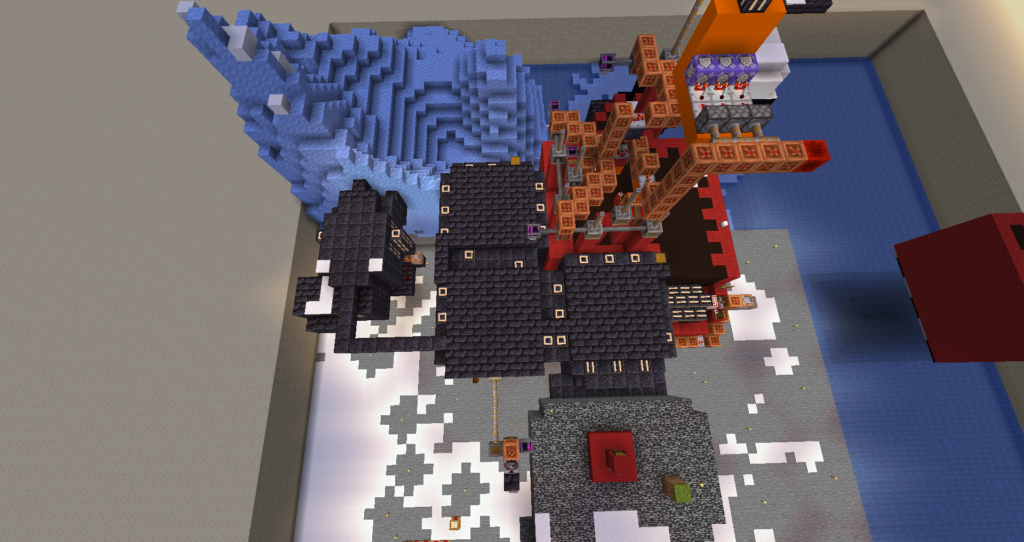
Initially we ran into the problem of getting in and out from our enclosed rooms to the outside where we work on the commands and redstone. Toggling between spectator view (where you could move through walls) and creative mode (where you could build) took a long time, and we needed to get back and forth rapidly to test. For a while we resorted to simply breaking blocks to get through and then replacing them later, but we’d often be left with holes that were forgotten. One day we logged on to see this simple yet ingenious contraption Theodore crafted which he dubbed “the unlidder”. Now, with the flip of a switch we could open and close the entire roof of this puzzle. It was all smooth sailing from there.
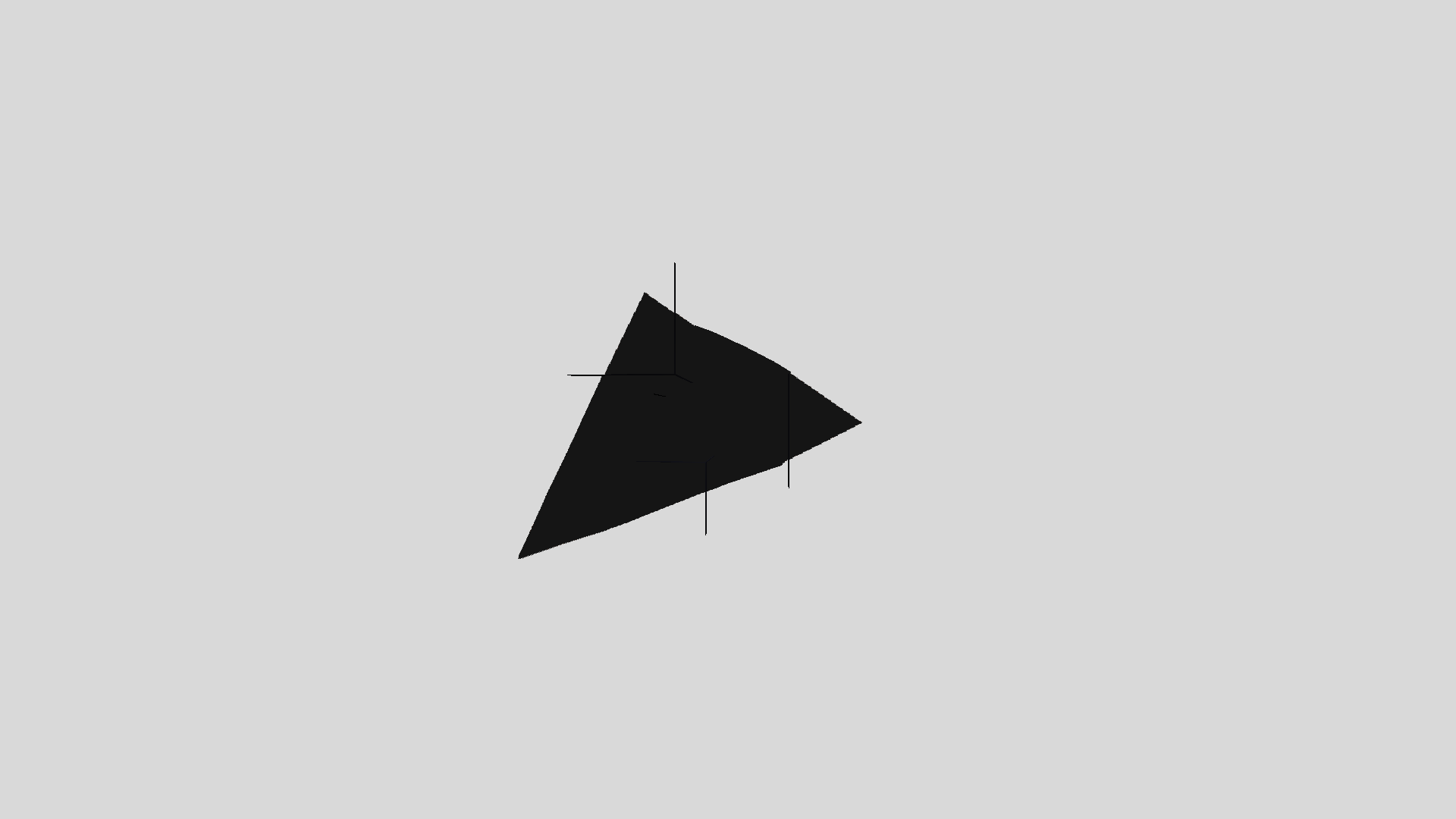
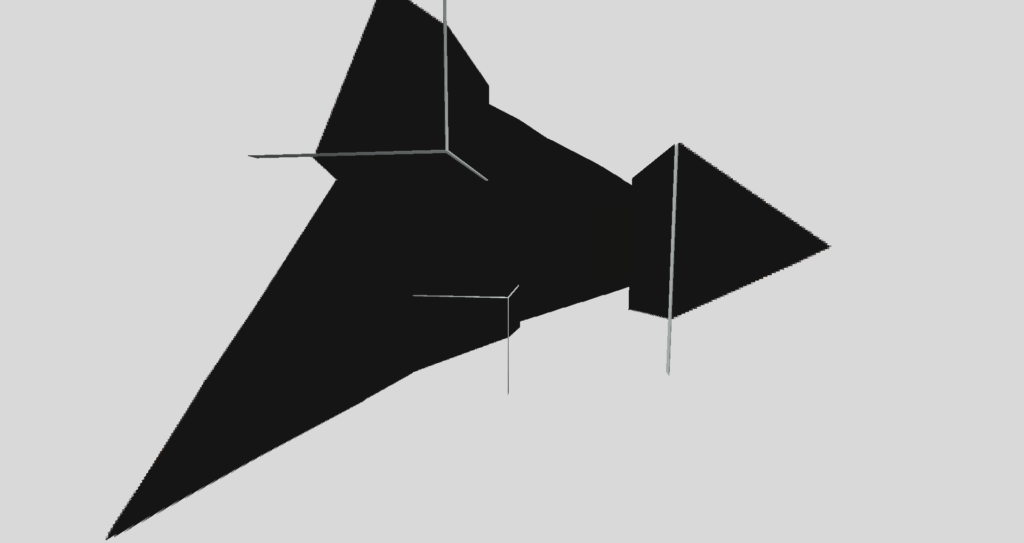

Standard Minecraft play is relatively agrarian and pre-modern. While custom modpacks full of mechanical components and magical capabilities work at unsettling this, most gameplay elements remain resolutely cutesy, representational and kitsch as well. We knew that the mechanics of the escape room would need to use game elements, so there was no question that much of the project would be firmly rooted in Minecraft’s own aesthetic vernacular. Therefore, it became a question of looking for moments where the experience could be discordant and visually unfamiliar in order to enhance the experience of disembeddedness in the escapees. Initially the goal was purely visual confusion, with references pulled from World War I dazzle camouflage, op art (including Bridget Riley’s Movement in Squares in the lobby). and television test patterns, all designed to be as jarring as possible. Over time, the project was injected with elements designed to evoke the sublime, using light and shadow, and eventually anamorphosis, to create environments that, while appealing, are also determinedly “not Minecraft”.
The escape room design continually pushes the player in and out of moments of familiarity. The anamorphosis room plays with a jarring 2D illusion in a 3D space before spitting the player back out into a world they know very well. Have they escaped? The player soon discovers that this world isn’t theirs to consume, one block at a time. In fact, it may just consume them.
Surprisingly, this brief section that looks completely naturally generated was one of the most difficult to get aesthetically right. We wanted it to look familiar and make the players believe their escape was successful. The plains and forest biomes are some of the oldest in Minecraft and therefore the most identifiable. The problem is that trying to make something look accidental often leads to too much meticulousness and attention to detail leading to things looking too artificial. This is something we just ended up embracing– we wanted familiar Minecraft overworld music to trigger as you stepped out into the open. However, an error on our end caused the track to be triggered multiple times leading to a cacophony of instruments overlapping that is nightmarish. Every once in the while a familiar riff of nostalgic Minecraft music will poke through but overall it is harsh noise. We decided to leave it in; it felt like weaponized nostalgia and doesn’t last too long. All sounds are stopped when you fall into the meat rooms that lurk beneath.
The longest sequence of rooms between puzzles was the *meat hallway*—partly because it’s an extended mild hint for the death bridge puzzle, but also because it most obviously fit in with one of the readings. Pictured here is the lower part of the first proper room in the meat hallway. Players fall down a long shaft after stepping on a trapdoor in the outdoor section and land in a tightly constrained room with only a hole in the floor. The first drop was a trick, but the players have to do the second drop themselves into this meaty-walled room. Initially, it was just a small room with a door into a bifurcated hallway, but in our first playtest, one player ran ahead by themselves and and their teammates ended up ignoring the visuals of the space in favour of catching up. So we modified three of the rooms in the meat hallway so that it would be less likely that one person would run ahead. While later rooms include some mechanic to slow down players, making it less likely that players would get separated, this first room requires that all three are present to continue.
At the midpoint of the left, right, and back walls are each placed a small black button. When pressed simultaneously by all three players, the wall at the end of the hallway shifts to create an exit. The exit is formed by each row of blocks pulling open; the top and bottom pull to the left, while the middle pulls to the right, giving the impression that the room is transforming more profoundly than just revealing a door. The fleshy intestinal-like or brain fold-like texture is reminiscent of the throbbing organic walls and floors which appear in the “hell” stages of Doom (1993).
This is the one of the more unsettling of the rooms that we built. Originally it was a drop down from the passage where the camera is placed to the floor, and through a door at the end. Just a small one-way room to push players forward, and also replicate the feeling of falling from earlier in the sequence. When we realized we needed to slow players down, we closed off the door at the end and made a maximalist version of the button gate from earlier. The left and right walls are covered with buttons, extending up to a ceiling which is too high to reach. A couple of the buttons will trigger a doorway to form on the far wall, but there is no particular logic or signal to which ones will do it. All the others are inert, not connected to any mechanisms. Our assumption was that players, already primed by the previous room to understand that buttons open doors, would start pressing them indiscriminately, in the hope that one would allow progress.
When Theodore and his partner first adopted their cat, Handpig, she was just under a year old but had already given birth to a litter of kittens, some five or six weeks earlier. She was at the time still very small, covered in black fur, with small patches of white under her chin and between her legs. But, fresh off nursing her kittens, she still had the rows of swollen, engorged nipples protruding from her black fur. She seemed so young still that it seemed totally incongruous—how could this tiny body support a mess of little ones? Originally, Theodore put two rows of buttons on each wall in inverted imitation of the cat’s nipples, which was more evocative of something animal. The final version of the buttons is more unsettling (when Theodore first posted a screenshot to our Discord chat, the rest of us were horrified), but also better provokes the button-mania that Theodore had hoped players would experience. When all you have are buttons, what is there to do but press them all?
There is a schoolyard rhyming game that begins, “Hi, my name is Joe, and I work in a button factory”. As the song progresses, the narrator is instructed by their boss to mime pushing the button with their right hand, their left hand, each foot, knees, elbows, etc. The song doesn’t make it clear whether a button factory is one which is operated via buttons, or is also one which creates buttons via button presses, but based on how “[noun] factory” is usually deployed (car factory, chemicals factory) we can assume the latter. So to push a button in a factory is a recursive action. Factories produce the conditions which allow industrialization to expand: factories beget factories.
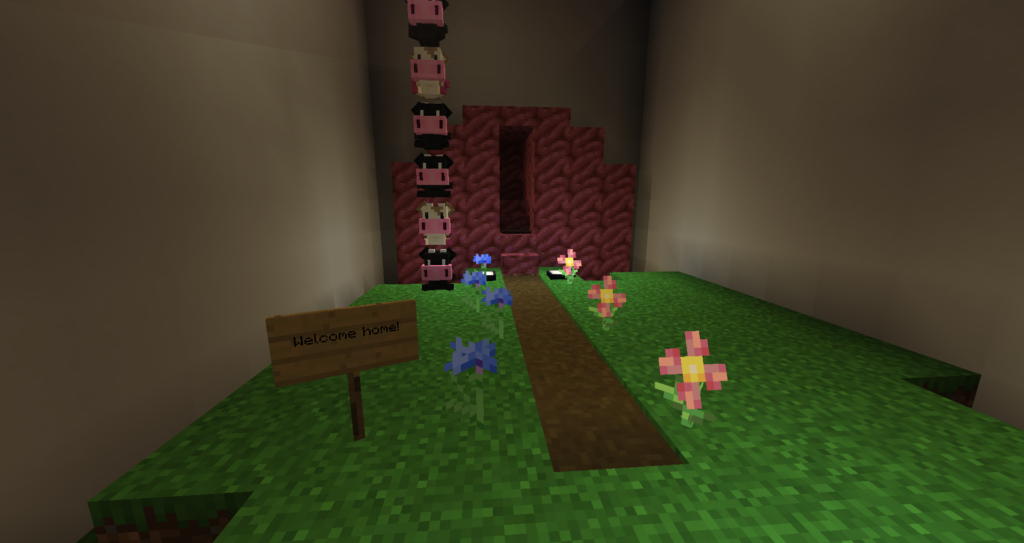
Nat built three meat room prototypes to test out different approaches to the meat section, and we ended up using them all, stitching them together into one big meat hallway. This was before we made many modifications to resolve the issues that came up during the playtesting phase. Nat tried to make them morbidly funny and uncanny; the goal was that the players would be weirded out by the very sudden cartoonish gore they were being forced to interact with.
The players are given one last connection between the meat rooms and the solution to the final puzzle. The image above shows how one of the meat rooms nods back to the false exit into the entirely gated and constructed “nostalgic nature” area that immediately precedes them. This vision of nature is just as artificial. The stacked cows provide a specific clue, and as the players move forward, they trigger a chute that starts dropping pigs, slowly at first, but with ever increasing speed. With a squeal the pigs plummet to their deaths, one after another.
The Death Bridge puzzle is the only puzzle where you need to die, a lot, to pass. The meat rooms and pig grinding machine that came before set players up with the darker tone of this puzzle, but in playtesting we found it to still be a shock to some. In fact, we had some varied reactions to this puzzle. Some play testers loved jumping into the chasm again and again, and found it fun, while others were horrified by it and hesitant to sacrifice their avatar for the greater good.
On the class server where this was initially hosted, there were pollution mods. Essentially, anywhere there was death, or destruction, there was carbon and fog which stuck around in the air. At first this added to the gloomy atmosphere of this puzzle, but eventually it became an issue with players no longer able to see. To mitigate this, we built a large chimney with filter systems in place, which still exists in our current pollution-free iteration.
A key challenge to the designing of the death bridge puzzle was the period of invincibility which players are given when they respawn after death. Originally, the puzzle just placed players back at the start of the wide conveyor belt ahead of the pit when they died, but in our first tests, the result was that after respawning, players who did not resist the conveyor’s movement would be thrown into the pit before the invincibility had run out and be unharmed by the fall. This led players to believe that falling into the pit was not a part of the solution, as it appeared to have no effect. The first solution was to build the shaft pictured here. The spawn point was shifted to its top, meaning the players spawned in with a fall, extending the time from respawn to pit by a few seconds, and also emphasizing falling as a key property of the room. Unfortunately, when we tested it, we found that the invincibility period was somewhat variable based on server lag—sometimes players would be hurt by the initial drop down the shaft, and sometimes players still wouldn’t be hurt by the drop down the pit, even with the extra time added. To adjust again, the shaft was made shorter, so that it wasn’t tall enough to cause players damage when they fell down it, but an additional winding conveyor belt was made the new spawn point so that another few seconds were added to the overall time. Even under heavy server load, the invincibility was finished before players reached the pit the vast majority of the time, and fall damage from the initial shaft was exceedingly rare (although still occasionally happened, probably due to lag).
When Nat was first envisioning the death bridge puzzle, part of their thoughts went back to our iteration of the class. Near the end of the semester, brain already full of ideas relating to discourses of embodiment due to the subject matter Nat was researching for their final paper, they logged in to class one day and witnessed dozens of player deaths taking place across the server, for reasons not understood. Nat didn’t manage to figure out exactly what was happening until much later, all they remember is their half-awake caffeine-less autopiloted mind being confused by the sudden piling up of dead bodies and hasty instantaneous burials (the class modpack also had gravestones). Nat did their usual investigative rounds of the server and found tombs piled on top off each other, most of them belonging to the same three people. It was strange because it was really screwed up, in a way, but also kind of funny because it wasn’t really real. Obviously, no deaths were actually happening. Based on that memory, they jotted down the concept for the death bridge. From the get-go Nat was thinking about the puzzle as a way to have players think about physical trauma as a bodiless entity, or maybe, half-bodied entity, and also, as a way of reflecting on the mechanization of death.
Throughout this whole project and the two iterations of the class embodiment has been a prominent focus of Nat’s thinking. Both of their class papers were about that. Embodiment in the digital space is interesting because it’s a bit of an in-between space in terms of existence. The interactive components of video games, to various degrees, engage more of the user’s body and places them in a more active role. The escape room, in its adaptation of the concepts from the class readings, provides a somewhat more tangible demonstration of the abstract concepts therein. As digital artists embodiment is always relevant, because digital media has always stood in juxtaposition to traditional/analog media and there’s obviously a big history of discourse on the subject. See: Simon Penny, W. J. T. Mitchell, etc.
Embodiment is also limited in such a way that facilitates the escape from physical limitations that put individuals at a disadvantage in a physical world; things like distance, disability, and physical appearance (think of the link between VR chat, gender identity and anime girl avatars; or online anonymity and being only known by a username in an online community versus being required to present yourself with your legal name and other identifiable information in real life).
This room, a replica of an installation by Esther Stocker for AR/GE Kunst Galerie Museum Bozen, was one of the earliest aesthetic ideas for the escape room. Like so many of the interstitial and liminal spaces, it is designed to aesthetically disembed the player from the Minecraft experience. It is also a musing on the nature of the grid. Darren Wershler and Bart Simon write in Childhood’s End (Or, We Have Never Been Modern, Except In Minecraft) that “Minecraft is not a game about blocks; it is a game about grids. The use of the grid as a cultural technique extends back into classical antiquity, but in modernity and beyond the grid is very powerful: it is the condition of possibility for the integration of aesthetics, governmentality, and computational logic.” Stocker’s original work embodies the rigor and rationality of the grid, while completely undermining it. Her grids never quite line up perfectly, and are consistently interrupted. Our Minecraft interpretation follows suit, and adds another layer of disruption. Minecraft grids are square, exacting, orderly. In this room, they are negated — rectangular, uneven, never quite right.
The loot room is meant to be exuberant, a colorful release from the black & white theme that runs across the project. The escapees have succeeded, and they are being richly rewarded. The room hums like a television test pattern, tiny pixels converging into colorfields, the room click-click-clicking as if trying to find a signal.
At the very end of the escape room you are presented with a glimpse behind the curtain. Up until this point, the various contraptions and redstone circuits are hidden from the player’s view. There is a strange rustic aesthetic to the blocks added by some of the mods we are using, and when they work in tandem an oddly satisfying beauty is seen. This contraption seen during the credits is great opportunity to show off how the machinery looks in action. When walking between rooms, players trigger a pressure plate on the ground which activates the circuit for a short amount of time. Rewards are pumped out of infinite storage drawers into hoppers onto conveyors which lead to dispensers. These dispensers are activated by giant pointer fingers going back and forth on a track which press gold buttons rhythmically– which gives us the static-like clicking described earlier. It took a lot of trial and error, and there are probably many ways it could be built more efficiently… but this is our contraption. We made it our own, and that’s the beauty of Minecraft.
While some contraptions use a wide assortment of blocks, most contraptions rely on four crucial blocks to get the job done. These staple blocks being: the redstone block and sticky piston (from the base game), the cog block (from the “Supplementaries” mod), and finally the powered latch (from the “Create” mod). While a lot of the redstone could potentially be done in vanilla Minecraft, these blocks saved a lot of time, space, and prevented headaches. Supplementaries’ cog block granted us freedom in where we layout our redstone wires, since these could travel vertically unlike Minecraft’s redstone dust which can only travel horizontally and diagonally. The cog block could also be pushed and pulled with a sticky piston, allowing us to make circuits that can close or open depending on whether or not observed objectives are met. There is an example of this mechanism at 3:09 in the video above. A redstone block always holds the maximum redstone charge and we use cogs to get the charge from point A to E, where point A is the redstone block. Points B through D are cog blocks that act as wire-sections that can be physically pushed or pulled into or out of the chain with sticky pistons. Point E is a powered latch that, once the chain is complete, toggles into a permanently on state becoming a de facto redstone block activating whatever comes next (e.g. a long piston or command block).
This project was made possible thanks to the generous support of the Concordia Lab for Innovation in Teaching and Learning (LITL).
